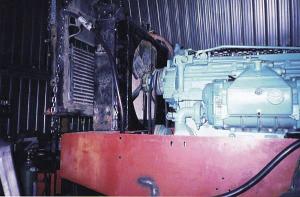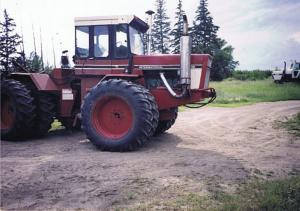International 4386 Repowered With Detroit Diesel
"When the engine went out on my 4386 International tractor for the third time and the tach showed only 4,100 hrs., I figured it was time to do something different than a straight overhaul," says retired Alberta farmer Ed Sokalski. "I had this nice 6-71 Detroit diesel engine in my shop, so I decided to put it in the tractor."
Sokalski had done engine overhauling before, but he had never tackled a complex engine replacement. "When I started the project I was almost 75 years old with two bad knees. People thought I was nuts, but I set out to prove them wrong."
A veteran farmer who had "fixed just about anything that could be fixed" in 55 years on the farm, Sokalski dived into the project full speed ahead. He removed the original 466 engine and had hopes of easing the 6-71 in place using the same mounting brackets and same housings. It turned out the 6-71 was 1 1/2 in. longer and about 1 in. wider, so it wouldn't fit. Sokalski had to make new mounting brackets for the rear of the engine and had to cut out and hone a cross member on the tractor frame to compensate for the size difference in the front.
"Even with those modifications, mounting the 6-71 wasn't too bad," says Sokalski. "Because of the extra length, I had to move the radiator, the grill and the hood forward 1 1/2 in. I also modified the fenders and created additional space for the air cleaner."
Sokalski mated the hydraulic pump to the new engine by machining a short shaft connected through two U-joints. The flywheel and engine housing for the 6-71 was a scant 3/4 in. different from the 466, but it might as well have been a foot apart, Sokalski says. "I looked for an adaptor from different sources and the cheapest one was $2,500, which I thought was way too much." Instead, he went to Dunbar Engine Sales in Edmonton and paid $250 for a used flywheel. The clutch assembly bolted to the flywheel, and after another $100 to have the setup balanced at Reliable Engine, the 6-71 slid into place. Electrical and fuel line connections were easy to hook up, as was the flexible exhaust pipe. Sokalski removed and cleaned all the injectors, so the engine "fired up after turning over just a couple times," he says.
More important, Sokalski adds, the inline 6 two-stroke "Screaming Jimmy" 6-71 has better torque than the 466. It has worked flawlessly for several hundred hrs. in the field, easily pulling a 32-ft. field cultivator, a 24-ft. disk or an 11-yd. scraper."
Sokalski says the total project took him about 50 to 60 hrs. to figure out and another 50 to 60 hrs. to measure, level, produce parts and install the engine.
Contact: FARM SHOW Followup, Edward Sokalski, P.O. Box 158, Lavoy, Alta., T0B 2S0 Canada (ph 780 658-2466).

Click here to download page story appeared in.
Click here to read entire issue
International 4386 Repowered With Detroit Diesel ENGINES Engines When the engine went out on my 4386 International tractor for the third time and the tach showed only 4 100 hrs I figured it was time to do something different than a straight overhaul says retired Alberta farmer Ed Sokalski I had this nice 6-71 Detroit diesel engine in my shop so I decided to put it in the tractor Sokalski had done engine overhauling before but he had never tackled a complex engine replacement When I started the project I was almost 75 years old with two bad knees People thought I was nuts but I set out to prove them wrong A veteran farmer who had fixed just about anything that could be fixed in 55 years on the farm Sokalski dived into the project full speed ahead He removed the original 466 engine and had hopes of easing the 6-71 in place using the same mounting brackets and same housings It turned out the 6-71 was 1 1/2 in longer and about 1 in wider so it wouldn t fit Sokalski had to make new mounting brackets for the rear of the engine and had to cut out and hone a cross member on the tractor frame to compensate for the size difference in the front Even with those modifications mounting the 6-71 wasn t too bad says Sokalski Because of the extra length I had to move the radiator the grill and the hood forward 1 1/2 in I also modified the fenders and created additional space for the air cleaner Sokalski mated the hydraulic pump to the new engine by machining a short shaft connected through two U-joints The flywheel and engine housing for the 6-71 was a scant 3/4 in different from the 466 but it might as well have been a foot apart Sokalski says I looked for an adaptor from different sources and the cheapest one was $2 500 which I thought was way too much Instead he went to Dunbar Engine Sales in Edmonton and paid $250 for a used flywheel The clutch assembly bolted to the flywheel and after another $100 to have the setup balanced at Reliable Engine the 6-71 slid into place Electrical and fuel line connections were easy to hook up as was the flexible exhaust pipe Sokalski removed and cleaned all the injectors so the engine fired up after turning over just a couple times he says More important Sokalski adds the inline 6 two-stroke Screaming Jimmy 6-71 has better torque than the 466 It has worked flawlessly for several hundred hrs in the field easily pulling a 32-ft field cultivator a 24-ft disk or an 11-yd scraper Sokalski says the total project took him about 50 to 60 hrs to figure out and another 50 to 60 hrs to measure level produce parts and install the engine Contact: FARM SHOW Followup Edward Sokalski P O Box 158 Lavoy Alta T0B 2S0 Canada ph 780 658-2466
To read the rest of this story, download this issue below or click
here to register with your account number.








